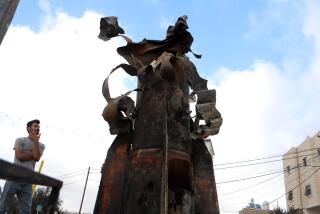Searching the maze of Iran
- Share via
The Iranian Labyrinth
Journeys Through Theocratic Iran and Its Furies
Dilip Hiro
Nation Books: 418 pp., $16.95 paper
*
AMERICAN policy toward the pivotal nation of Iran has vacillated widely since World War II.
In 1953, the Central Intelligence Agency, assisted by Britain’s MI-6, overthrew Iran’s prime minister, Mohammad Mossadegh, after he nationalized the Anglo-Iranian Oil Co. Shah Mohammad Reza Pahlavi was restored to power. Later, the Nixon administration declared the shah a stand-in for U.S. interests in the Middle East.
But in 1979, America turned hostile after the shah’s government fell to Islamic revolutionaries who held hostages in the U.S. Embassy for 444 days and the Ayatollah Ruhollah Khomeini returned from exile to lead the new Islamic Republic of Iran. When Iraq attacked Iran in 1980, America supported Iraq against its enemy.
But later in the 1980s, the Reagan administration covertly sold U.S. arms to Iran for money to fund the anti-Sandinista Contra rebels in Nicaragua, at a time when Congress outlawed direct U.S. aid to the Contras. By 1998, then-Secretary of State Madeleine Albright called for a road map toward normalization of relations between the United States and Iran. Then in his 2002 State of the Union speech, President Bush said Iran, along with Iraq and North Korea, constituted an “axis of evil, arming to threaten the peace of the world.” Now the United States and other nuclear powers are trying to get Iran to refrain from joining the nuclear weapons club.
With such a history it is no wonder that Iranians regard the U.S. government with deep suspicion. But what is Iran and who are its people and what motivates them? Such questions have bedeviled U.S. policymakers and Western students of this nation of 68 million people.
Unfortunately, “The Iranian Labyrinth” by Dilip Hiro, a journalist and author of many books on Iraq and Iran -- including “The Longest War,” considered a definitive history of the nine-year Iran-Iraq conflict -- does not help much. It is stuffed with facts. It has a useful chronology and a helpful glossary of Iranian terms and a list of important figures throughout its long history. But it lacks the breath of life that would make vivid this large and important nation and its complex people.
Hiro divides his chapters into topics. He covers the Iranian bazaar, that “crucible of trade, religion and politics,” a bit of ancient and a lot of recent, detailed Iranian history. He discusses the role of Islam in its several guises (Shiism is the dominant Islamic faith in Iran), outside interveners, the British and the Americans, and the long and continuing struggle between the modernizing forces and the Islamic leadership.
Hiro believes that for now, anyhow, the traditionalists have prevailed. “Having captured all the ... organs of the state,” he writes, “the conservatives are likely to compromise on social and economic reform while insisting on retaining monopoly of political power.”
Yet he argues that Iranians fear continuing threats and attempts at intimidation from Washington and the possibility of U.S. intervention in another “preventive war” against them. “The net effect of this U.S. policy,” he writes, “is to strengthen the hands of conservatives and hard-liners at the expense of reformists and moderates.”
Indeed, outgoing Iranian President Mohammad Khatami on Wednesday announced that his country’s scientists would continue to try to enrich uranium, which can be used in weapons and power plants, whether or not Europe and the United States approve. He also noted that they have developed the technology to improve the accuracy of missiles able to reach nearby U.S. bases and Israel. The incoming president, Mahmoud Ahmadinejad, the ultraconservative mayor of Tehran, has criticized the government for negotiating and caving to Western pressure. He and others insist that Iran has a right to develop nuclear technology.
*
Anthony Day, the former editor of The Times editorial pages, is a regular contributor to Book Review.
More to Read
Sign up for Essential California
The most important California stories and recommendations in your inbox every morning.
You may occasionally receive promotional content from the Los Angeles Times.










